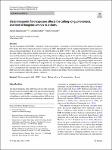Thông tin tài liệu
Thông tin siêu dữ liệu biểu ghi
| Trường DC | Giá trị | Ngôn ngữ |
|---|---|---|
| dc.contributor.author | Wyszkowska, Joanna | - |
| dc.contributor.author | Kobak, Jarosław | - |
| dc.contributor.author | Aonuma, Hitoshi | - |
| dc.date.accessioned | 2023-08-14T04:11:07Z | - |
| dc.date.available | 2023-08-14T04:11:07Z | - |
| dc.date.issued | 2023 | - |
| dc.identifier.uri | https://link.springer.com/article/10.1007/s11356-023-28981-0 | - |
| dc.identifier.uri | https://dlib.phenikaa-uni.edu.vn/handle/PNK/8798 | - |
| dc.description | CC-BY | vi |
| dc.description.abstract | The electromagnetic field (EMF) is ubiquitous in the environment, constituting a well-known but poorly understood stressor. Few studies have been conducted on insect responses to EMF, although they are an excellent experimental model and are of great ecological importance. In our work, we tested the effects of EMF (50 Hz, 7 mT) on the cricket Gryllus bimaculatus: the male calling song pattern, female mate choice, and levels of biogenic amines in the brain. Exposure of males to EMF increased the number and shortened the period of chips in their calling song (by 2.7% and 5% relative to the control song, respectively), but not the sound frequency. Aged (3-week-old) females were attracted to both natural and EMF-modified male signals, whereas young (1-week-old, virgin) females responded only to the modified signal, suggesting its higher attractance. | vi |
| dc.language.iso | en | vi |
| dc.publisher | Springer | vi |
| dc.subject | EMF | vi |
| dc.subject | EMF-modified male signals | vi |
| dc.title | Electromagnetic field exposure affects the calling song, phonotaxis, and level of biogenic amines in crickets | vi |
| dc.type | Book | vi |
| Bộ sưu tập | ||
| OER - Khoa học môi trường | ||
Danh sách tệp tin đính kèm:

